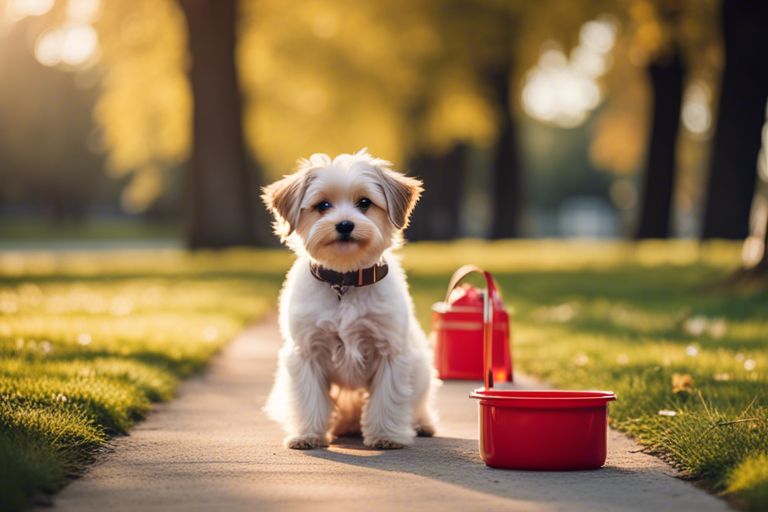With the growing popularity of small dog breeds, it has become crucial for pet owners to master the art of obedience training to ensure a harmonious relationship with their furry companions. In this comprehensive guide, we will explore the top 10 steps to perfecting obedience training for small dogs, providing you with the knowledge and tools necessary to establish clear boundaries and communication with your canine companion.
Key Takeaways:
- Consistency is key: Small dogs thrive on routine and consistency in their training. Make sure to establish clear rules and boundaries and consistently reinforce them.
- Use positive reinforcement: Reward good behavior with treats, praise, or playtime. Small dogs respond well to positive reinforcement and will be more motivated to obey commands.
- Keep training sessions short and engaging: Small dogs have short attention spans, so keep training sessions brief and fun. Incorporate games and interactive toys to make training sessions enjoyable for your small dog.
Establish Training Goals
Define achievable objectives
While begining on obedience training for your small dog, it’s crucial to define clear and achievable objectives. This could include commands such as sit, stay, heel, or come. By setting specific goals, you provide direction for your training sessions and give your dog a clear understanding of what is expected.
Set a timeframe
Assuming you have defined your training objectives, the next step is to set a timeframe for achieving them. Some dogs may pick up commands quickly, while others may require more time and patience. It’s important to be realistic in your timeline to prevent frustration for both you and your furry companion. Consistency and regular practice are key to success in obedience training.
Goals should be specific, measurable, achievable, relevant, and time-bound (SMART). By following these principles, you can track your progress effectively and adjust your training methods as needed to ensure success in obedience training for your small dog.
Choose Appropriate Rewards
Identify motivational treats
One vital step in obedience training for small dogs is identifying what treats motivate them the most. Small dogs can have varying preferences when it comes to treats, so it’s important to observe what your dog responds to best. Some small dogs may prefer soft treats, while others may be more motivated by crunchy rewards. By identifying your dog’s favorite treats, you can use them as a powerful tool in training sessions.
Diversify reward types
Appropriate rewards for small dogs extend beyond just treats. While treats are effective motivators, it’s also crucial to diversify the types of rewards you use in training. Small dogs may respond well to verbal praise, belly rubs, or playtime as rewards. By incorporating a variety of rewards, you can keep your dog engaged and excited during training sessions, leading to better results.
Recognizing what motivates your small dog is key to successful obedience training. Using a mix of treats, praise, and playtime can help keep your dog engaged and eager to learn.
| Treats | Verbal praise |
| Belly rubs | Playtime |

Create a Training Schedule
Set regular sessions
Not establishing a consistent training schedule can hinder your small dog’s progress. Set aside specific times each day for training sessions to help your dog get into a routine and understand when to expect training.
Keep training short
An necessary aspect of obedience training for small dogs is to keep the sessions brief yet focused. Small dogs have shorter attention spans, so keeping the training sessions short ensures they stay engaged and retain the information better.
For the best results, aim for training sessions that last between 5 to 10 minutes. It’s better to have multiple short sessions throughout the day than to have one long, exhaustive session. This way, your small dog stays motivated and doesn’t get overwhelmed with too much information at once.
Introduce Basic Commands
Start with “sit”
You can begin teaching your small dog basic obedience commands by starting with “sit.” This command is fundamental and sets the foundation for more advanced training. To start, hold a treat close to your dog’s nose and slowly move your hand up, prompting them to lower their hind end to the ground. As soon as they sit, reward them with the treat and praise. Repeat this process consistently until your dog reliably follows the command.
Progress to “stay”
For small dogs, mastering the “stay” command is crucial for their safety and obedience. Once your dog is comfortable with sitting on command, you can introduce “stay.” Have your dog sit, then show them your palm and say “stay” in a firm voice. Take a step back and reward them for staying in place. Gradually increase the distance and duration of their stay as they become more proficient.
With time and practice, your small dog will learn to remain in place even when faced with distractions. Consistency and patience are key to successfully teaching them the “stay” command.
Reinforce Positive Behavior
Use consistent rewards
Now, one of the key aspects of obedience training for small dogs is to use consistent rewards. When your small dog behaves well, make sure to reward them immediately with treats, praise, or affection. This will help them understand which behaviors are desirable and encourage them to repeat those actions in the future.
Ignore negative actions
There’s a common misconception that small dogs can be bossy or stubborn, but in reality, they are just looking for guidance and leadership. Ignore negative actions such as barking, whining, or jumping up to get attention. By withholding your attention when they misbehave, you are teaching them that those behaviors will not be rewarded.
Rewards should only be given when your small dog displays the desired behaviors, such as sitting quietly or following a command. By consistently reinforcing positive behavior and ignoring negative actions, you will be well on your way to perfecting obedience training for your small dog.
Socialize Your Dog
Despite their small size, small dogs benefit greatly from socialization. It helps them become well-adjusted and confident in various situations.
Schedule playdates
Any opportunity to expose your small dog to new people, other dogs, and different environments is beneficial. By arranging playdates with well-behaved dogs, you can help your pet learn appropriate social behavior and build positive associations.
Visit dog parks
While dog parks can be overwhelming for some small dogs due to the size and energy of larger breeds, they can still be valuable socialization settings. Visiting during quieter times or finding smaller dog-specific areas within the parks can help your pet gradually acclimate to the environment and interact with other dogs in a controlled manner.
Visiting dog parks provides opportunities for your small dog to practice social skills like sharing toys, taking turns, and reading other dogs’ body language. It also allows them to burn off excess energy and expend mental stimulation through new sights and smells.
Address Barking Issues
Teach “quiet” command
Issues with excessive barking are common among small dogs, but teaching the “quiet” command can help curb this behavior. Start by catching your dog in the act of barking, then firmly say “quiet” and wait for a moment of silence. Reward this moment of quiet with a treat to reinforce the behavior.
Distract from triggers
If your small dog is prone to barking at specific triggers such as other dogs or noises, distracting them can be an effective way to address this behavior. Utilize toys, treats, or a favorite game to redirect their attention away from the trigger and onto a positive activity.
Issues may arise when your small dog is overwhelmed by their triggers and struggles to calm down. In these situations, providing a quiet and safe space for them to retreat to can help them relax and minimize barking episodes.
Implement Leash Training
Choose suitable harness
Implementing leash training begins with choosing the right harness for your small dog. Select a lightweight harness that fits comfortably without causing any strain or discomfort. Avoid using collars, especially for breeds with delicate necks, as they can lead to injury or choking during walks. Opt for a harness that distributes pressure evenly across the chest and shoulders for optimal control and safety.
Practice outdoor walking
Assuming your small dog is comfortable wearing the harness, it’s time to practice outdoor walking. Start in a quiet and familiar environment to help your dog adjust to the new sensation of being on a leash. Use positive reinforcement techniques like treats and praise to encourage good behavior while walking. Gradually increase the duration and distance of walks as your dog becomes more confident and responsive to your commands.
With consistency and patience, your small dog will learn to walk calmly on a leash, making outdoor adventures enjoyable for both of you.
Counteract Small Dog Syndrome
Avoid reinforcing fear
Your small dog’s behavior can be influenced by fear, leading to aggressive or anxious responses. Avoid reinforcing fearful behavior by not coddling or comforting your dog when they are frightened. This can inadvertently reinforce their fear response, making it more likely to occur in the future. Instead, stay calm and provide a sense of security through your own confident demeanor.
Promote confidence
With consistent training and positive reinforcement, you can help promote confidence in your small dog. Confidence-building activities such as agility training, socialization with other dogs, and exposure to various environments can help your dog develop a more secure sense of self. By encouraging and reinforcing confident behavior, you can help counteract Small Dog Syndrome and create a well-rounded, obedient pet.
By reinforcing positive behaviors and providing a consistent routine, your small dog will learn to trust their environment and respond confidently to different situations. Building confidence in your small dog is crucial for combating Small Dog Syndrome and ensuring a well-behaved and happy companion.
Conclusion
Drawing together the 10 steps to perfecting obedience training for small dogs, it is evident that consistency, patience, and positive reinforcement are key factors in achieving success. By setting clear boundaries, establishing a routine, and using rewards effectively, small dogs can be trained to be obedient and well-behaved companions. Remember that each dog is unique and may require different approaches, so be flexible in your training methods and always prioritize the bond with your furry friend. With dedication and the right techniques, you can enjoy a harmonious relationship with your small dog built on trust and respect.
FAQ
Q: Why is obedience training important for small dogs?
A: Obedience training is crucial for small dogs to ensure they understand boundaries, follow commands, and stay safe in various situations. It also helps strengthen the bond between the owner and the dog.
Q: How can I start obedience training for my small dog?
A: To begin obedience training for your small dog, start with basic commands such as sit, stay, come, and heel. Use positive reinforcement techniques like treats and praise to encourage good behavior.
Q: What are some common mistakes to avoid during obedience training for small dogs?
A: Some common mistakes to avoid during obedience training for small dogs include being inconsistent with commands, using punishment instead of positive reinforcement, and expecting too much too soon. Patience, consistency, and positive reinforcement are key to successful obedience training.

